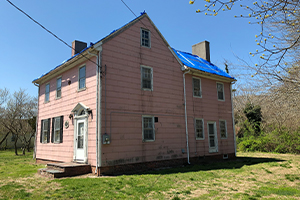Judge Nathaniel Foster House
Grant Award: $15,000 (2012); $38,850 (2018); $150,000 (2024) Grant Recipient: Cape May County Historical & Genealogical Society County: Cape MayMunicipality: Lower Township
The Judge Nathaniel Foster House is an architecturally significant resource in Lower Township, Cape May County. The house was built by Nathaniel Foster ca. 1727, a local Justice of the Peace, using heavy timber frame construction on a brick foundation. The house and property were passed down through the Foster family and was substantially remodeled around 1826 in the Federal Style, of which many elements remain. The Federal Style work was likely done by Reuben Foster, Nathaniel Foster’s great grandson, who was listed as a “house carpenter” in the 1860 census. Although much of the land was parceled off and sold, the house remained in the Foster family until 2006 when it was sold to the Cape May County Historical and Genealogical Society. Facing economic constraints, the Society put the house up for sale in 2015 and received an offer from Dollar General. The community voiced overwhelming support to save the house from demolition prompting Cape May County to purchase the house. Cape May County currently leases the house to Lower Township and the Township has undertaken the stewardship and management of the resource. Much of the original historic fabric remains, both interior and exterior. Evidence of the heavy timber framing is visible in many of the second-floor rooms and Federal Style elements remain throughout the interior. It is locally significant under criterion C.
The 2024 Trust grant will help fund Phase 1B Archaeological Survey, stabilization of outbuildings, enclosed porch repairs and site improvement to allow for ADA access (LU/LA lift, packed gravel parking and pathway), rebuild chimneystacks from mid-level of the attic up, conservation of first floor fireback in parlor, new steps and landing at side entrance, and electrical upgrades.
The 2018 grant helped fund the preparation of design and construction documents, an architectural conservator report, professional construction cost estimations, a Phase 1A archaeological investigation, an interpretive and furnishings plan, and a hazardous materials audit. The 2012 Trust grant helped fund the preparation of a National Register nomination and conditions assessment.
 Official Site of The State of New Jersey
Official Site of The State of New Jersey
